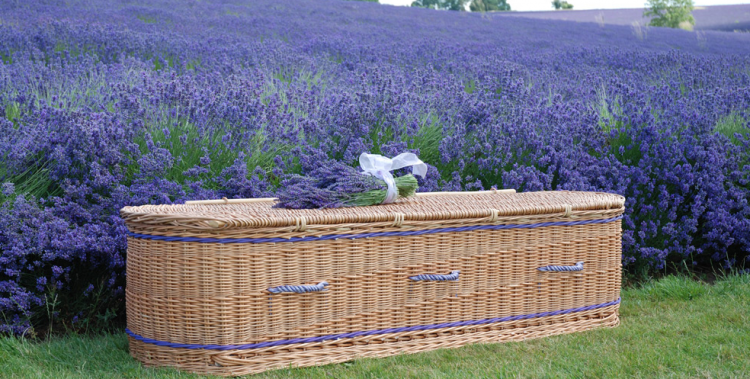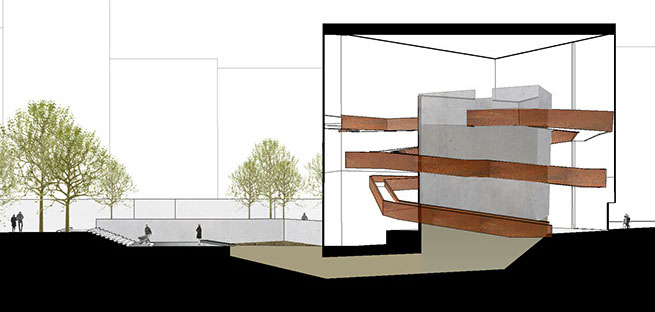 According to the Central Intelligence Agency’s World Factbook, the worldwide human death rate averages nearly 8 per 1,000 in population. With over six billion people on the planet, that’s about 55.3 million deaths per year — 151,600 a day, 6,316 an hour, 105 a minute, and nearly 2 per second. That’s a lot of bodies to dump.
According to the Central Intelligence Agency’s World Factbook, the worldwide human death rate averages nearly 8 per 1,000 in population. With over six billion people on the planet, that’s about 55.3 million deaths per year — 151,600 a day, 6,316 an hour, 105 a minute, and nearly 2 per second. That’s a lot of bodies to dump.
Conventional cemetery burial and fossil-fuel cremation are the two main means of corpse disposal but both have drawbacks by way of cost, use of natural resources, and effects on the environment. Today, many people are looking for alternate solutions in sending-off their dearly departed.
Here are eight other effective ways to dispose of a body.
 1. Promession is the process of freeze-dying human remains. Whereas cremation incinerates a body resulting in ash (ashes to ashes—dust to dust, as the saying goes), promession produces .04 inch (1 millimeter) diameter particles of organic material that can be returned to the earth in many ways.
1. Promession is the process of freeze-dying human remains. Whereas cremation incinerates a body resulting in ash (ashes to ashes—dust to dust, as the saying goes), promession produces .04 inch (1 millimeter) diameter particles of organic material that can be returned to the earth in many ways.
The process is relatively simple… and gentle.
 First, the corpse is frozen at 0 degrees Fahrenheit (-18 Celcius) and then placed in a vat of liquid nitrogen where the temperature drops to -320 Fahrenheit (-196 Celcius). A mechanical device vibrates the body which disintegrates in minutes, then the material is freeze-dried in a vacuum chamber, removing the water and reducing the weight to thirty percent of the original mass. Metals such as fillings and artificial devices are picked-out then the dry powder is placed in an urn and returned to the family.
First, the corpse is frozen at 0 degrees Fahrenheit (-18 Celcius) and then placed in a vat of liquid nitrogen where the temperature drops to -320 Fahrenheit (-196 Celcius). A mechanical device vibrates the body which disintegrates in minutes, then the material is freeze-dried in a vacuum chamber, removing the water and reducing the weight to thirty percent of the original mass. Metals such as fillings and artificial devices are picked-out then the dry powder is placed in an urn and returned to the family.
2. Biodegradable caskets and burial shrouds are replacing exotic wood and metal coffins which used to be buried six feet underground in crowded, designated cemeteries. The thinking was to preserve the body as long as possible and delay the natural decomposition process.
Today, innovative interment containers made of wicker, bamboo, seagrass, cotton, or banana leaves break down quickly when laid in the earth’s organic layer which averages two feet in depth.
 3. Green or woodland burials are becoming popular throughout North America where land space in rural areas is still readily available. Recognizing that a human body is designed to naturally recycle in the earth after death, families choosing green burials have their member return to the earth.
3. Green or woodland burials are becoming popular throughout North America where land space in rural areas is still readily available. Recognizing that a human body is designed to naturally recycle in the earth after death, families choosing green burials have their member return to the earth.
Green burial spaces respect the natural environment by encouraging grass and tree growth which are fertilized by organic compounds in human bodies. Gravesites are marked through GPS coordinates rather than by headstones.
4. Eternal Reefs combine a cremation urn, ash scattering, and burial at sea into one meaningful, permanent environmental tribute to life.
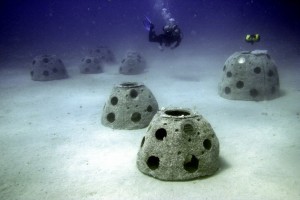 Reef balls have been used for years. There are over 700,000 reef balls used in more than 4,000 projects in over 70 countries and are considered the gold standard in artificial reef development and restoration—particularly in building coral reefs.
Reef balls have been used for years. There are over 700,000 reef balls used in more than 4,000 projects in over 70 countries and are considered the gold standard in artificial reef development and restoration—particularly in building coral reefs.
Brilliantly designed, the balls are made of Ph-neutral concrete and are round, hollow, and perforated to allow the flow of water and population by marine life. Eighty percent of the weight is built into the bottom of the balls preventing them from being washed away by currents or storms.
 Human remains, whether diminished by cremation or promession, can be mixed with the concrete or set in individual pockets built into the reef ball. Creating a healthy and sustainable marine environment is a wonderful tribute to a passed friend.
Human remains, whether diminished by cremation or promession, can be mixed with the concrete or set in individual pockets built into the reef ball. Creating a healthy and sustainable marine environment is a wonderful tribute to a passed friend.
4. Green Embalming replaces the toxic, carcinogenic method of using formaldehyde fluids in preserving a cadaver whether the purpose is to make viewing presentable or long distance shipping possible.
 For thousands of years, civilizations have been using organic compounds in their mortuaries. They include essential oils like pine, juniper, onion, and palm, as well as resins like lichen, oloeo-gum, beeswax, cassia, bitumen, and myrrh. Frankincense was used to mask odors and bodies were washed in wine.
For thousands of years, civilizations have been using organic compounds in their mortuaries. They include essential oils like pine, juniper, onion, and palm, as well as resins like lichen, oloeo-gum, beeswax, cassia, bitumen, and myrrh. Frankincense was used to mask odors and bodies were washed in wine.
These naturally occurring precursor agents are non-polluting and environmentally stable, unlike the chemicals found in traditional embalming fluid. While initially retarding a body’s breakdown, the effects quickly wear off and allow decomposition to proceed, which is what mother nature intended.
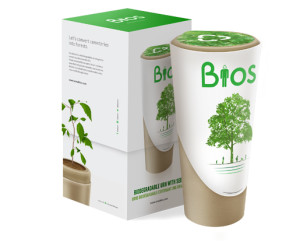 5. Bios Urns allow someone become a tree. This patented product is essentially a cone or a sphere which contains soil, the deceased’s ashes, and a seed. The urn itself is biodegradable so you just plant the entire container, water it, and watch a sapling tree sprout from what used to be a relative.
5. Bios Urns allow someone become a tree. This patented product is essentially a cone or a sphere which contains soil, the deceased’s ashes, and a seed. The urn itself is biodegradable so you just plant the entire container, water it, and watch a sapling tree sprout from what used to be a relative.
The Bios Urns website offers a choice of plantings including maple, pine, gingko, beech, or ash as well as providing for custom orders. There’s also an app which alerts your smart phone of a need for hydration or an automatic watering system can also be bought.
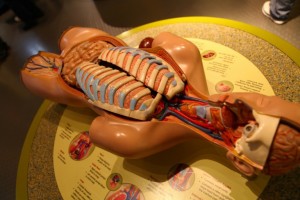 6. Donating a body to medical science has been an option available for years and it’s always in demand. Anatomical students need actual human cadavers for study and dissection and it’s an honorable use of deceased remains to provide schooling for the next generation of doctors and researchers.
6. Donating a body to medical science has been an option available for years and it’s always in demand. Anatomical students need actual human cadavers for study and dissection and it’s an honorable use of deceased remains to provide schooling for the next generation of doctors and researchers.
Although there’ve been huge technological advancements in anatomical models and computer generated simulators, there’s nothing quite like the real thing for practicing professionals.
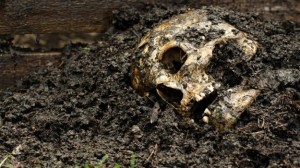 7. Donating a body to forensic science is another option and something relatively new. Since the success of The Body Farm, which was pioneered by Dr. Bill Bass of the University of Tennessee Anthropological Research Facility near Knoxville, six more farms were developed to study the decomposition process of human remains to aid in the forensic investigation of human deaths.
7. Donating a body to forensic science is another option and something relatively new. Since the success of The Body Farm, which was pioneered by Dr. Bill Bass of the University of Tennessee Anthropological Research Facility near Knoxville, six more farms were developed to study the decomposition process of human remains to aid in the forensic investigation of human deaths.
These farms accept over one hundred bodies per year and currently have in excess of thirteen hundred registered donors—when their time comes.
8. Human composting is a concept that’s proposed but not yet in operation. Architect Katrina Spade’s Urban Death Project is a dignified way to turn remains into nutritive compost as quickly as possible.
The Urban Death Project is more than just a compost-based renewal system. It’s a new model for death care in overcrowded cities and is replicable, scalable, not-for-profit, and totally beneficial to the planet.
 In a bold departure to the status quo—never before have humans been composted—the Urban Death Project will be an architectural first that’s built as a three-storey compost core. Ramps will allow a funeral procession to carry a shrouded deceased to the top of the bin and conduct a service before “laying-in”.
In a bold departure to the status quo—never before have humans been composted—the Urban Death Project will be an architectural first that’s built as a three-storey compost core. Ramps will allow a funeral procession to carry a shrouded deceased to the top of the bin and conduct a service before “laying-in”.
The body is not embalmed as fast decomposition is essential to the process. Over the span of a few months, aerobic and microbial activity transforms the deceased—along with others—into a rich, organic compost that can be used to fertilize urban spaces such as rooftop edible gardens.
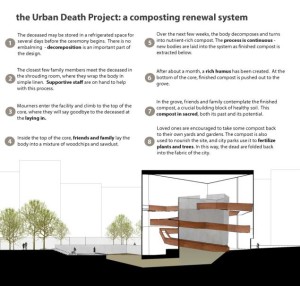 The Urban Death Project is working with Western Carolina University’s Forensic Osteology Research Station (FOREST) in studying the human composting process to develop a safe, effective, and dignified way of caring for the deceased. Osteology is a specialized branch of anthropology that deals with studying bone structure.
The Urban Death Project is working with Western Carolina University’s Forensic Osteology Research Station (FOREST) in studying the human composting process to develop a safe, effective, and dignified way of caring for the deceased. Osteology is a specialized branch of anthropology that deals with studying bone structure.
The organization aims to “fundamentally alter the way that Western Society thinks about death. The goal is to un-do the over-commercialization and needless distance currently created between ourselves and this inevitable human event”.

